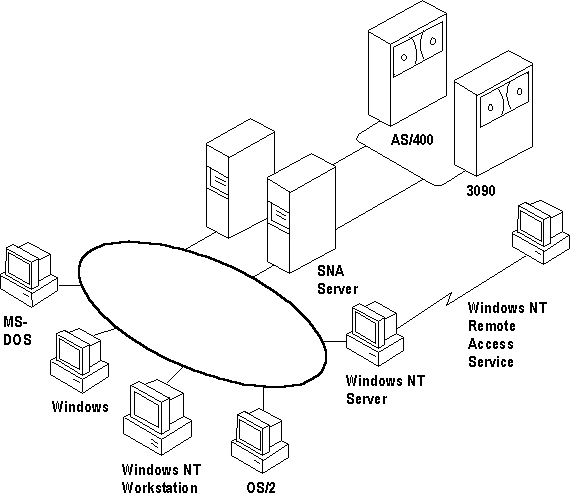
Although such simple one-to-one connections can suffice for many basic operations, most enterprises require more flexible connectivity between IBM host computers and local area networks (LANs). To meet this need, Microsoft SNA Server exploits client-server architecture to link desktop personal computers to IBM mainframe and midrange computers that are accessible using the Systems Network Architecture (SNA) protocols. The client personal computers can run Windows NT, Windows, MS-DOS, OS/2, or the Macintosh operating system and can use standard LAN protocols to connect to the server; only the computer running SNA Server must run the SNA protocol. Each personal computer user can have multiple 3270 and 5250 sessions for concurrent terminal and printer emulation, including file-transfer and Emulator High-Level Language API (EHLLAPI) applications. SNA Server for Windows NT also provides support for the following APIs for distributed SNA applications:
The client-server architecture of SNA Server makes it possible to off-load communications processing from client systems, permitting them to use their system resources more efficiently. Client personal computers do not have to run one protocol to access the LAN and another to access the SNA host. Instead, each personal computer can run Microsoft-based networking (named pipes), TCP/IP, IPX/SPX, AppleTalk®, or Banyan® VINES®, within a single-protocol or mixed network, to access the SNA server. The SNA server routes the connection to the appropriate host computer via the SNA protocol. The SNA server automatically balances the user load across multiple host connections and servers to provide optimal throughput.
The client-server architecture also provides Windows NT-based applications with the ability to access information on IBM mainframes and midrange computers. For example, using SNA Server, mail servers can access PROFS, and Microsoft SQL Server can access DB2 information.

Figure 2.3 SNA Server Connecting LANs to IBM Host Computers
In addition to standard personal computer connections, SNA Server supports Downstream Physical Units (DSPUs), any SNA device or personal computer running a full PU 2.0 (SNA cluster controller) protocol stack. These systems use the SNA server as a concentrator gateway for connecting to IBM hosts. Examples of some of the DSPU clients that SNA Server supports are IBM OS/2 Communications Manager/2 clients and IBM 3174 cluster controllers. The DSPU protocols that SNA Server supports are DLC over token ring or Ethernet, Synchronous Data Link Control (SDLC), and OSI-standard X.25/QLLC (Qualified Logical Link Control).
SNA Server provides API support for bidirectional communications with NetView, IBM's mainframe-centered network management system. SNA Server can send application- or system-defined Windows NT event-log messages to NetView and can enable Windows NT commands to be executed from the NetView console. For example, if an SNA Server database is stopped on the LAN, an alert can be sent to the NetView console. A data center operator can then send a command from the NetView console to the Windows NT computer to restart the server.
SNA Server also supports Response-Time Monitor (RTM) and user-defined alerts for third-party 3270 emulators.
Network administrators can administer all SNA servers from a centralized location, such as from a LAN workstation or a NetView console. For example, a company with offices in several cities could have one or more SNA Servers at each site. The MIS department at corporate headquarters can manage all of these SNA servers, performing all administrative functions remotely.
SNA Server is supported on all the hardware platforms supported by Windows NT. SNA Server relies on the built-in security of Windows NT, so administrators need to manage only a single set of user accounts. SNA Server also is fully integrated with Windows NT system monitoring and management services, and provides automatic server and connection fault tolerance. SNA Server for Windows NT is completely 32-bit and multithreaded for maximum performance, scalability, and reliability.
SNA Server is fully compliant with Microsoft's Windows Open Services Architecture (WOSA), providing a consistent interface to enterprise computing environments and hiding the complexities of connectivity from applications.
SNA Server provides for as many as 250 simultaneous host connections by each server and up to 2,000 users and 10,000 sessions per server.